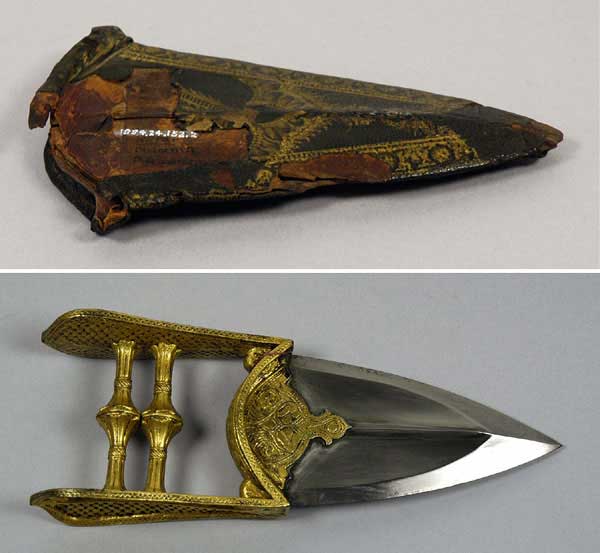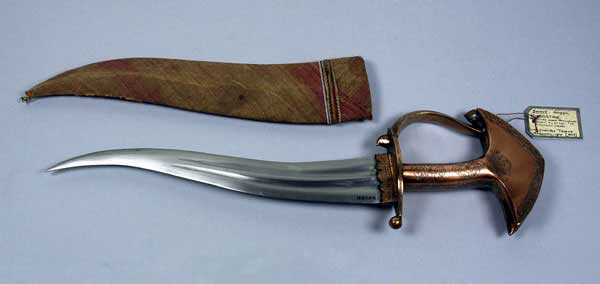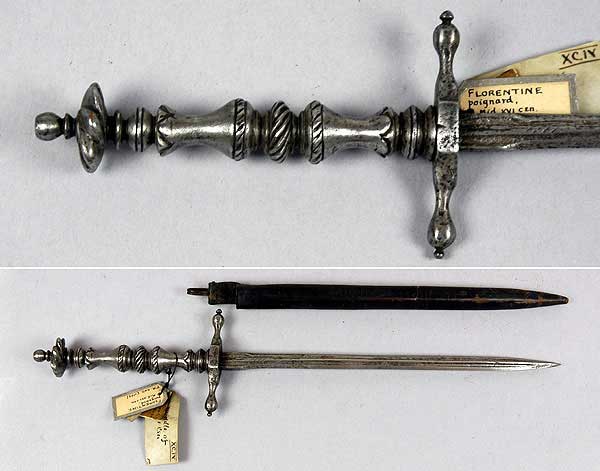Dagger (V7)
A Weapon

From the Combat, Weapons and Equipment (V7) section of the 7.2 Rulebook
A slashing or piercing weapon up to 18 inches long. At least ten inches of its total length must be Strike-Legal (V7) in order to slash.
Check the Weapon Types (V7) Section for more information
Who uses this?
Basic Equipment (V7) for all classes. If taken by a magic using class it costs no Magic Points (V7).
About Daggers

A dagger (from Vulgar Latin: 'daca' - a Dacian knife) is a typically double-edged blade used for stabbing or thrusting. They often fulfill the role of a secondary defense weapon in close combat. In most cases, a tang extends into the handle along the centreline of the blade.
Daggers may be roughly differentiated from knives on the basis that daggers are intended primarily for stabbing whereas knives are usually single-edged and intended mostly for cutting. However, many or perhaps most knives and daggers are usually very capable of either stabbing or cutting.
Much like battle axes, daggers evolved out of prehistoric tools. They were initially made of flint, ivory, or even bone and were used as weapons since the earliest periods of human civilization. The earliest metal daggers appear in the Bronze Age, in the 3rd millennium BC, predating the sword, which essentially developed from oversized daggers. Although the standard dagger would at no time be very effective against axes, spears, or even maces due to its limited reach, it was an important step towards the development of a more useful close-combat weapon, the sword.
However, almost from the very beginning of Egyptian history, daggers were adorned as ceremonial objects with golden hilts and later even more ornate and varied construction. Traditionally, military and naval officers wore dress daggers as symbols of power, and modern soldiers are still equipped with combat knives and knife bayonets.
Historically, knives and daggers were always considered secondary or even tertiary weapons. Most cultures mainly fought with pole weapons, swords, and axes at arm's length if not already utilizing bows, spears, slings, or other long-range weapons. Roman soldiers were issued a pugio.
From the year 1250 onward, gravestones and other contemporary images show knights with a dagger or combat knife at their side. The hilt and blade shapes began to resemble smaller versions of swords and led to a fashion of ornamented sheaths and hilts in the late-15th century.
The dagger is symbolically ambiguous. It may be associated with cowardice and treachery due to the ease of concealment and surprise that someone could inflict with one on an unexpecting victim — many assassinations were reportedly carried out using one. Victims of such assassinations included Julius Caesar, who suffered from 23 stab wounds from irate members of the Roman Senate. On the other hand, the dagger may symbolically suggest a determination to courageously close with the enemy.

A use on the battlefield could be against a heavy armored opponent. Heavy armor would also mean great fatigue and after an opponent had been disabled by blows with a heavier weapon (bludgeoning him but not actually harming him) the dagger could be inserted into the eye-slits of the helm killing the downed knight more or less instantly.
The increasing sophistication of sword fighting and a prevailing sense of chivalrous honour caused knives and daggers to lose their popularity as weapons in Medieval times, only to regain it during the Renaissance in the form of the stiletto, which proved to be very effective against the plated body armor popular at the time.
In that age, books offering instruction on the use of weapons prescribed that the dagger be held in the hand with the blade pointing from the heel of the hand, and used by making downward jabs. This technique would differentiate a dagger wound from that of a sword. A sword wound was noble and, as the possession of swords was limited to aristocrats, could be caused only by such weapons. Murder by dagger thrusts was ignoble, and could be done by commoners or vengeful aristocrats who wished to remain anonymous. This is why a group of political murders is called Night of the Long Knives, although daggers were not literally used.
With the development of firearms, the dagger lost more and more of its usefulness in military combat; multipurpose knives/bayonets and handguns replaced them. However, beginning with the 17th century, another form of dagger — the plug bayonet and later the socket bayonet — was used to convert muskets and other longarms into spears by mounting them on the barrel.
Daggers achieved public notoriety in the 20th century as ornamental uniform regalia during the Fascist dictatorships of Mussolini's Italy and Hitler's Germany. The resurgance of these dress daggers and accoutrements in post-WW1 Germany gave a much needed boost to the flagging fortunes of the metalworking center Solingen. Dress daggers were used by several other countries as well, including Japan but never to the same extent as those worn by the Military and Political bodies of the Third Reich.
As combat equipment they were carried by many infantry and commando forces during the Second World War. British commandos had an especially slender dagger, the Fairbairn-Sykes fighting knife, developed from that used in Shanghai. U.S. Marine Corps Raiders in the Pacific carried a similar fighting dagger, and others were fashioned for American forces and their allies from cut-down World War I Patton sabers.